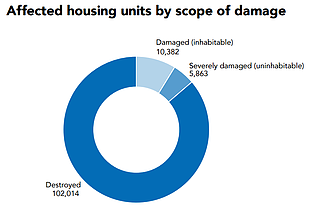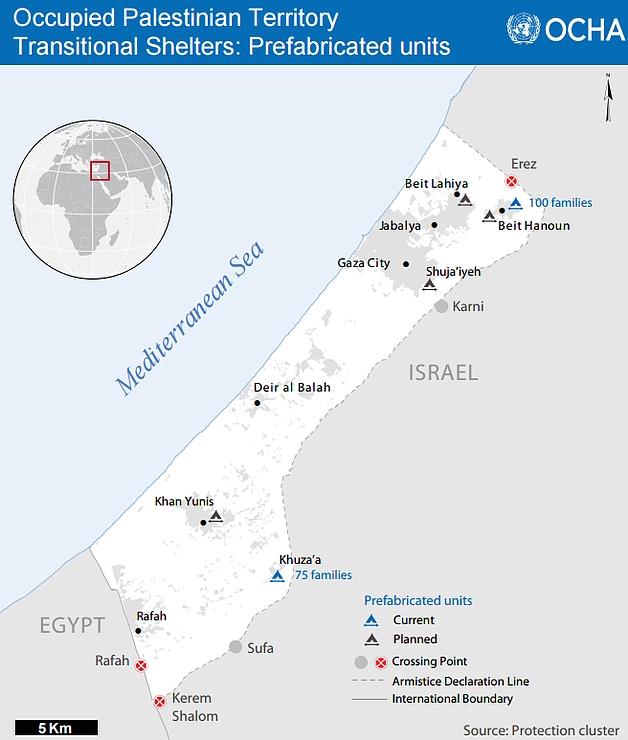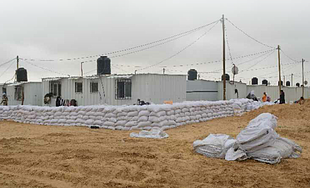Up to 19,600 families remain displaced across the Gaza Strip
Initiatives to establish prefabricated units in temporary displacement sites raise serious concerns
 Shelter needs in the aftermath of the July-August hostilities are enormous. The nearly final figures emerging from the damage assessments carried out by the Ministry of Public Works and Housing (MoPWH), UNDP and UNRWA indicate that over 118,000 housing units have been affected, of which 12 per cent were totally destroyed, seven percent severely damaged and rendered uninhabitable, and the rest damaged to varying degrees.[1] It is estimated that up to 19,600 families (118,000 people) living in homes included in the first two categories have been displaced and are in need of medium and long term solutions. Meanwhile, imports of construction materials remain low in light of these needs.
Shelter needs in the aftermath of the July-August hostilities are enormous. The nearly final figures emerging from the damage assessments carried out by the Ministry of Public Works and Housing (MoPWH), UNDP and UNRWA indicate that over 118,000 housing units have been affected, of which 12 per cent were totally destroyed, seven percent severely damaged and rendered uninhabitable, and the rest damaged to varying degrees.[1] It is estimated that up to 19,600 families (118,000 people) living in homes included in the first two categories have been displaced and are in need of medium and long term solutions. Meanwhile, imports of construction materials remain low in light of these needs.
Transitional shelter solutions
IDPs whose homes were totally destroyed or severely damaged are currently accommodated in seven types of arrangements/facilities:
- Host families
- Rented apartments
- Collective centres
- Prefabricated units
- Winterized tents
- Makeshift shelters
- Heavily damaged homes.
Due to the lack of a consolidated registration system and missed opportunities during damage assessments, the precise distribution of IDPs by type of arrangement remains largely unknown, with the exception of those in UNRWA collective centres who account for about 15 per cent of all IDPs (approximately 20,000 people).[2]
For most of the displaced, the rental of an apartment is considered the optimal solution for the transitional period pending reconstruction, but the available housing stock can accommodate only a small percentage of all IDPs and rental costs have more than doubled. Despite improvements in the quality of services to IDPs, UNRWA-administered shelters, established in 18 schools, are not designed for long-term residence and remain largely overcrowded.
A transitional shelter solution made available to Shelter Cluster partners is the provision of prefabricated units sited individually, in small groups, or in temporary displacement sites of up to 50 units. Currently, there are two temporary displacement sites with prefabricated units established in Khuza’a village (East Khan Younis), housing 75 families, and next to destroyed homes in Beit Hanoun (Northern Gaza), accommodating 100 families.[3]
Discussions are underway to assess the feasibility of other temporary displacement sites, including near the devastated Ash Shujai’yeh neighbourhood in eastern Gaza City, in Beit Hanoun and in Khan Younis. This is in addition to the distribution of prefabricated units to individual families, usually erected next to their destroyed home or in their neighbourhood. Overall, various international donors have committed to fund approximately 7,000 prefabricated housing units worth at least $49 million including site preparation and transport.

The establishment of large temporary displacement sites with prefabricated units raises significant challenges and concerns. In addition to the relatively high costs, the limited availability of land may lead to cramped sites with inadequate layout. This solution also requires families to relocate yet again and face related difficulties, including access to family support networks, services and employment opportunities.
The experience of families already accommodated in prefabricated units has been problematic with scant attention given to the need for support to IDP communities. A survey conducted by MoPWH indicates that less than 30 per cent of affected families are willing to relocate to prefabricated units, and only if those units are located next to their former homes. This latter option makes rubble removal difficult and poses significant risks to families.
Given the limited life of prefabricated units and the importance of focusing on the need for construction materials and durable shelter solutions, the appropriateness of this option should be reconsidered. The $49 million already pledged by donors for prefabricated units could, instead, be used to repair over 32,000 homes with minor damage, or 8,000 unfinished apartments, both of which would offer transitional solutions to accommodate IDPs, while the latter would also provide a much-needed boost to housing stock.
Reconstruction
Entry of building materials for reconstruction remains far below the amount required, particularly those materials considered by the Israeli authorities as “dual use items”, including aggregates, steel reinforcing bars and cement. During November, only 287 trucks carrying these three items entered Gaza, slightly less than the previous month, and less than half of what is required on a daily basis to sustain the reconstruction schedule. Imports in November constituted only 13 per cent of the equivalent figure in July 2013 when the private sector was permitted to import these materials.[4]
The Shelter Cluster estimates that over 100,000 housing units need to be built to meet Gaza’s housing needs, including the reconstruction of destroyed and severely damaged homes and addressing natural growth needs. To accomplish this within the three to five-year time frame planned, the inflow of construction materials into Gaza should be 735 truckloads per day, seven days a week for three years, or 441 truckloads seven days per week for five years.[5] This would require a significant expansion of the current crossing capacity because the Kerem Shalom crossing can reportedly handle only approximately 500 trucks a day of all types of goods. Between 2007 and 2010, Israel unilaterally closed the Karni, Sufa and Nahal Oz commercial crossings with Gaza.
The Temporary Gaza Reconstruction Mechanism (GRM), which has been up and running since September 2014, allows families whose homes have been assessed to purchase restricted building materials from designated private sector vendors authorized to import the materials. As of 9 December, 8,000 individuals whose houses had been assessed had been informed that they can purchase construction materials; approximately 70 per cent of these individuals have actually procured some of the materials, depending on their financial resources. Some agencies have faced technical challenges such as delays in the lists of eligible names and amounts of materials needed. Sales of stocks of the available materials are also slower than anticipated. A major difficulty is the lack of financial resources, many families do not have the means to purchase the required materials because they have not received the payments they are eligible for.
UNRWA has so far disbursed $19.5million for repairs to families whose homes sustained damage and $1.5million for TSCA to families whose housing unit was totally destroyed or rendered uninhabitable. UNDP is currently supporting 750 families with TSCA, and anticipates expanding its response to support a further 1,500 families. Shelter actors dedicated to meeting emergency winterization, transitional shelter and repair and reconstruction needs of refugee and non-refugee cases remain severely underfunded.
Flooding affects IDPs in prefabricated units
 Displaced families living in prefabricated units experience harsh living conditions, especially in winter conditions, and IDPs in Khuza’a’s two temporary displacement sites are no exception. Following heavy rain at the end of October and early November, families in the two sites experienced flooding and leaks when water seeped through the ceiling, along windowsills and under doors. With no provision for rain or storm water drainage, the sewage system overflowed and caused sewage to flood several prefabricated units, soaking family homes and their belongings. International organizations and the Municipality of Khuza’a have responded to the crisis to minimize flooding incidents. With funding from UNICEF, implementation by Action Against Hunger (ACF) through a local contractor, and facilitation by the municipality, sandbag barriers have been set up around both sites. Although heavier rain fell in the last week of November, no flooding took place in the sites, indicating success
Displaced families living in prefabricated units experience harsh living conditions, especially in winter conditions, and IDPs in Khuza’a’s two temporary displacement sites are no exception. Following heavy rain at the end of October and early November, families in the two sites experienced flooding and leaks when water seeped through the ceiling, along windowsills and under doors. With no provision for rain or storm water drainage, the sewage system overflowed and caused sewage to flood several prefabricated units, soaking family homes and their belongings. International organizations and the Municipality of Khuza’a have responded to the crisis to minimize flooding incidents. With funding from UNICEF, implementation by Action Against Hunger (ACF) through a local contractor, and facilitation by the municipality, sandbag barriers have been set up around both sites. Although heavier rain fell in the last week of November, no flooding took place in the sites, indicating success
* This article was contributed by the Palestine Shelter & NFI Cluster
[1] Gaza Shelter & NFI Cluster SitRep: 9 November 2014
[2] For details of the new management system applied by UNRWA in these collective centers, see OCHA, Humanitarian Bulletin, October 2014
[3] http://www.nrc.no/?did=9188937. The former site was established by the NGO Human Appeal International and is currently administered by the Municipality of Khuza’a.
[4] Gaza Shelter Cluster: ABC Materials (November 2014 update).
[5] Shelter Cluster Palestine: Gaza Shelter Update – 11 October 2014









